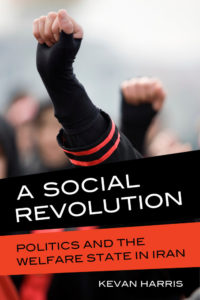The recent protests in Iran are unlikely to change who is in power. But they will spark a change of the system, led by the system, according to Dina Esfandiary, a Fellow in the War Studies Department at King’s College London, and an Adjunct Fellow at the Center for Strategic and International Studies (CSIS). The Islamic Republic has proved its skill at staying in power, and it now recognizes that it needs to adapt to remain. But it will have to tread more carefully than ever before, she writes for The Washington Post.
 Whether by coercion or negotiation, Iran’s political factions have been unable to stem the tide of social protest rising for the past several years, according to UCLA assistant professor Kevan Harris, the author of, “A Social Revolution: Politics and the Welfare State in Iran,” and Zep Kalb, a UCLA PhD student.
Whether by coercion or negotiation, Iran’s political factions have been unable to stem the tide of social protest rising for the past several years, according to UCLA assistant professor Kevan Harris, the author of, “A Social Revolution: Politics and the Welfare State in Iran,” and Zep Kalb, a UCLA PhD student.
“As with previous upsurges in post-revolutionary Iran, such popular mobilization tends to widen the cracks in elite competition within the country’s political establishment,” they write for The Washington Post’s Monkey Cage. “As these political factions jockey against each other, draw new lines of competition and attempt to mobilize popular support in upcoming political contests, popular disruption from below may create spaces where Iran’s political establishment will be forced to react in surprising ways yet again.”
The roots of the protests — frustration among the youth over their lack of freedoms and opportunities — remain just below the surface. And with the younger generation clearly exhibiting its willingness to take to the streets to express its anger over the status quo, the onus is on the Islamic republic’s aging leadership to bridge a growing generational divide, RFE/RL’s Frud Bezhan reports.

MEI
“Young Iranians hold higher expectations, have greater access to information and exposure to the outside world, and aspire to more freedoms and opportunities,” says Ahmad Majidyar, a South Asia and Middle East expert for the Washington-based Middle East Institute…..Nearly 60 percent of Iran’s population of 82 million is under the age of 35, and nearly 70 percent of Iranians were not yet born when the Islamic republic was established, according to the U.S. Census Bureau.
And, according to Majidyar, “they are deeply frustrated with economic and political stagnation in the country, and do not see the ruling political establishment as capable of addressing their needs.”
The award of a fellowship at the Shorenstein Center on Media, Politics, and Public Policy to Iranian blogger Hossein Derakhshan, an apologist for the Tehran regime, is causing some consternation. “The real concern here is the Kennedy School’s revolting moral negligence,” notes Sohrab Ahmari writes for Commentary.
 “Derakhshan has accused prominent Iranian dissidents and thinkers of spying for the U.S.–while the regime imprisoned these figures,” he adds. “As Haleh Esfandiari, a scholar at the Wilson Center, was languishing in the nightmarish Evin Prison in 2007, Derakhshan blogged”:
“Derakhshan has accused prominent Iranian dissidents and thinkers of spying for the U.S.–while the regime imprisoned these figures,” he adds. “As Haleh Esfandiari, a scholar at the Wilson Center, was languishing in the nightmarish Evin Prison in 2007, Derakhshan blogged”:
I know speaking against Haleh Esfandiari is like suicide these days. . . . [She] has become a symbolic victim of the ‘most repressive regime on the planet.’ . . . Haleh Esfandiari was the first Iranian fellow at the National Endowment for Democracy [the Washington-based democracy assistance group] in 1995. . . When another jailed scholar, the Iranian-Canadian philosopher Ramin Jahanbegloo, confessed to fomenting a “soft” revolution in a statement broadcast on Iranian state television, Derakhshan insinuated that Jahanbegloo was likely guilty as charged….
 The protests shaking provincial cities and towns in Iran since December 28, 2017 are a new and different phenomenon for the Islamic Republic. Young, politically voiceless people of modest means are apparently frustrated over the economic prospects and inequities they perceive, the Middle East Institute notes. MEI and Radio Free Europe/Radio Liberty (RFE/RL) provided an inside view of the demonstrations and how they contrast with the “Green Movement” of 2009 or an Iranian “spring” of the like that spread through the Arab world in 2011.
The protests shaking provincial cities and towns in Iran since December 28, 2017 are a new and different phenomenon for the Islamic Republic. Young, politically voiceless people of modest means are apparently frustrated over the economic prospects and inequities they perceive, the Middle East Institute notes. MEI and Radio Free Europe/Radio Liberty (RFE/RL) provided an inside view of the demonstrations and how they contrast with the “Green Movement” of 2009 or an Iranian “spring” of the like that spread through the Arab world in 2011.
The expert panel (above) featured Golnaz Esfandiari (RFE/RL), Ahmad Majidyar (MEI), Negar Mortazavi (Iran International), and Alex Vatanka (MEI). Ishaan Tharoor (The Washington Post) moderated the discussion.
Iran is in the “middle of a phase where people are rethinking issues of legitimacy and responsibility vis-a-vis their  leadership,” says Scott Lucas, an Iran specialist at Birmingham University in Britain.
leadership,” says Scott Lucas, an Iran specialist at Birmingham University in Britain.
“Many Iranians under 30 are facing challenges about whether they can fulfil their hopes and aspirations,” Lucas continues. “These are no longer necessarily defined by the Islamic Revolution. Instead, they are part of a world in which there are economic and political barriers to getting a good job, raising a family, being part of a community. These barriers cannot be met simply by invoking velayat-e faqih.”
“As we saw in the recent protests, dissatisfaction could escalate into a questioning of the legitimacy of Iranian institutions — and even the supreme leader is not exempt from this,” Lucas adds.







